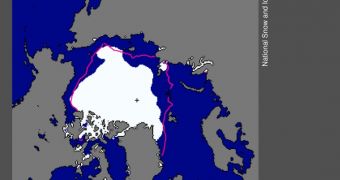Researchers at the National Snow and Ice Data Center (NSIDC) have calculated that the cryosphere is currently in better conditions than last year. In other words, the amount of ice available in the world's glaciers, polar caps and frozen lakes was higher at the end of this summer than in the previous years.
This less extensive surface melt is largely due to the cool and stormy conditions that characterized the season.
In September, the average ice extent in the Arctic was 5.35 million square kilometers (2.07 million square miles), a value significantly higher than what was recorded over the same month in 2012 (1.72 million square kilometers or 664,000 square miles).
The lowest sea ice extent at the North Pole is usually recorded on September 13. Beyond this date, strong autumn cooling usually contributes to a marked increase in sea ice throughout the Arctic.
Although these values may be construed as an indicator that the Arctic ice cap is recovering, climatologists point out that this year's levels are 1.17 million square kilometers (452,000 square miles) below the average recorded between 1981 and 2010.
Therefore, the 2013 results can be construed as a natural variation that occurs in the overall-descending trend of northern sea ice.
This hypothesis is also supported by the fact that this year's was the seventh summer on record when more than 10 million square kilometers of sea ice was lost during the warm season. Once of these instances occurred in 1990, while the other six all took place after 2007.
What this suggests is that the last decade marks an acceleration in northern ice loss trends. Data indicate that this September exhibited the sixth-lowest sea ice extent in the satellite record.
On the southern front, sea ices around Antarctica continued to grow in 2013, reaching 19.47 million square kilometers (7.52 million square miles) on September 22, a record high value in the 1981-2010 median range.
According to a paper published in the Journal of Climate by University of Washington by researcher Jinlun Zhang, this trend is largely due to shifting wind patterns at the South Pole, which promotes both the compacting and ridging of Antarctic ices.
The entire NSIDC analysis is available here.

 14 DAY TRIAL //
14 DAY TRIAL //